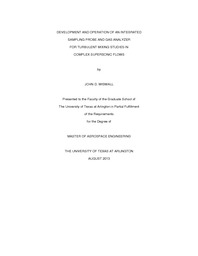| dc.description.abstract | For many aerospace applications, mixing enhancement between co-flowing streams has been identified as a critical and enabling technology. Due to short fuel residence times in scramjet combustors, combustion is limited by the molecular mixing of hydrogen (fuel) and air. Determining the mixedness of fuel and air in these complex supersonic flowfields is critical to the advancement of novel injection schemes currently being developed at UTA in collaboration with NASA Langley and intended to be used on a future two-stage to orbit (~Mach 16) hypersonic air-breathing vehicle for space access.Expanding on previous work, an instrument has been designed, fabricated, and tested in order to measure mean concentrations of injected helium (a passive scalar used instead of hazardous hydrogen) and to quantitatively characterize the nature of the high-frequency concentration fluctuations encountered in the compressible, turbulent, and high-speed (up to Mach 3.5) complex flows associated with the new supersonic injection schemes. This important high-frequency data is not yet attainable when employing other techniques such as Laser Induced Fluorescence, Filtered Rayleigh Scattering or mass spectroscopy in the same complex supersonic flows.The probe operates by exploiting the difference between the thermodynamic properties of two species through independent massflow measurements and calibration. The probe samples isokinetically from the flowfield's area of interest and the helium concentration may be uniquely determined by hot-film anemometry and internally measured stagnation conditions. The final design has a diameter of 0.25" and is only 2.22" long. The overall accuracy of the probe is 3% in molar fraction of helium. The frequency response of mean concentration measurements is estimated at 103 Hz, while high-frequency hot-film measurements were conducted at 60 kHz. Additionally, the work presents an analysis of the probe's internal mixing effects and the effects of the spatial-temporal characteristic scales of the flow on the resulting time-area-averaged concentration measurements. Two series of experiments were performed to verify the probe's design; the first used Schlieren photography and verified that the probe sampled from the supersonic flowfield isokinetically. The second series involved traversing the probe across a free mixing layer of air and helium, to obtain both mean concentration and high frequency measurements. High-frequency data was statistically analyzed and inspection of the Probability Density Function (PDF) of the hot-film response was instrumental to interpret how well the resulting average mixing measurements represent these types of complex flows.The probe is minimally intrusive, has accuracy comparable to its predecessors, has an improved frequency response for mean concentration measurements, and samples from a very small area in the flowfield. | en_US |

